About
Hello everyone. My name is Ruth Ŋalmakarra. And I’m going to tell a story about this Djalkiri Keeping Place.
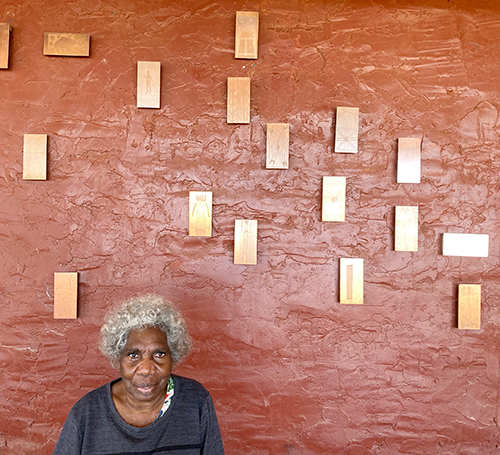
Those [things] of ours, from here, our djalkiri, those paintings, our foundations – they should come back to us. And stay here with us, at our Djalkiri Keeping Place. So that we can see them – all those old things made by our old people, those paintings, and teach the children – the young people that are growing up now, so that they can learn about them, about their djalkiri – their foundations – whose they are, so that they can look and recognise them. We’ll write in there who those people are and which clans the designs belong to – whose djalkiri they are. In there. That’s how it is, so that each child that is growing up now, we will teach them, bring them along with us. Like we will be naming the things in there, like that. Teaching. Old people will come and teach them – the children. That’s how it is. So that they will know. They won’t forget later on. They won’t leave those things behind later on – leave them – no. They will continue. When they want to know about something that they see in there, they will tell us, and we will show them. It will be here at the art centre. So that we can talk together and understand each other in our language, like that. Yes. And by and by other people will come, white people or whoever, they’ll see it too, this way, how this thing of ours, this collection we’re putting together, why we are bringing it back for ourselves and keeping it here. In here. For everyone to see, and for the children to see and learn.
Hello everyone. Ŋarra yäku Ruth Ŋalmakarra. Ga ŋarra dhu yäkuyam dhäwu about nhawi, Djalkiri Keeping Place. Ŋunhi dhuwalaŋuwuy nhakun limurruŋ, djalkiri gamunuŋgu’ – ŋayi dhu räli roŋiyirrnha. Ga dhiyalnha ŋayi dhu ga nhakun ŋunhi ŋorra limurruŋgal wäŋiya. Märr ga limurr dhu ga nhäma – ŋunhiyi mala ŋathiliŋu mala walalaŋguŋ limurruŋguŋ ḏilkurruwurruŋguŋ, biḏi’yunawuy, ga marŋgi-gurrupana djamarrkuḻi’nhan – yuṯa dhiyaŋbala ga ŋuthan, märr ga walal dhu marŋgithirrdhi ŋurukiyi djalkiriw mala – yolku mala ŋunhi, märr ga walal dhu nhäma dharaŋan ga. They will be learning.
Marŋgithirrnha walal dhu ga. Yolŋunhan malany nhakun wukurriny balayi yäku yolku mala nhakun djalkiri mala gamunuŋgu. Ŋunhidhi. Ya balanya märr ga limurr dhu ga each djamarrkuḻiny dhiyaŋbala ga ŋuthan ŋunhi limurr dhu ga marŋgi-gurrupan nhakun walalany, gäma walalany. Nhakun limurr dhu nhawi ya bitjan marrtji yäkuyam ŋunhidhi. Teaching. Old people-yu dhu marrtji ga marŋgi-gurrupan walalany djamarrkuḻiny. Ya balanya. Märr ga walal dhu marŋgi. Yaka walal dhu yalalaŋumirri moma. Yaka walal dhu ŋunhidhi yalalaŋumirri ganan’ – gunharra’yun walal dhu – yaka. Walal dhu continue. Ŋunhi walal dhu nhaku djälthi walal dhu ŋunhiyi nhäma, walal dhu waŋa napurruny, ga napurr dhu maŋutji-gurrupan walalaŋgal. Dhiyal nhakun arts centre-n dhu ga ŋayi ŋunhi ŋorrany. Märr ga limurr dhu waŋanhamirr ga dharaŋanmirr nhakun Yolŋukurrnha, ya balanya. Yow. Ga yalala nhakun Yolŋu wiripu dhu ga marrti Ŋäpaki nhawi mala balanya walal dhu nhawi, nhämadhi bili, nhawuku romgu, nhaltjan ŋayi ga limurruŋ dhuwal limurr ga ŋamaŋamayunmirr, Yolŋu mala, nhaltjan limurr dhu limurruŋguwuy limurr roŋanmaram ga dhiyalnha banydji ga ŋorra. Galkana dhipalnha. For everyone to see, ga Djamarrkuḻiw nhänharaw ga marŋgithinyaraw.
Ruth Ŋalmakara – Senior Garrawurra Clan Leader and Milingimbi Art and Culture Chairperson
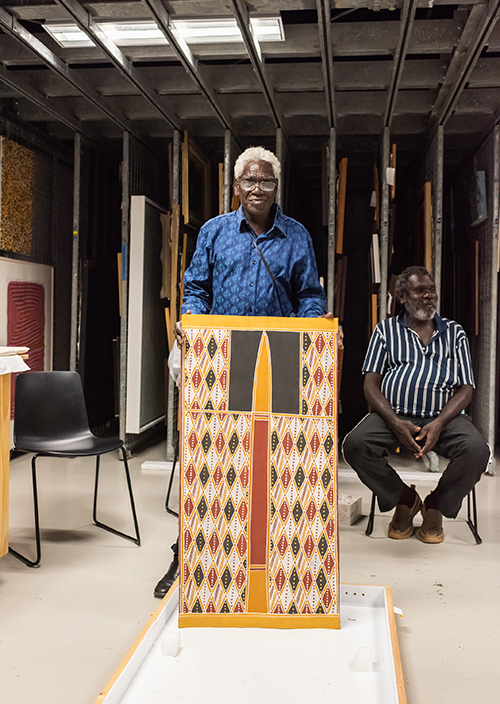
Many of my father’s and other old people’s paintings have been kept in the museum for a long, long time. We need to find these paintings because many have been mixed up with different names. I worry if we don’t put the right name and clan, the connections between the people and stories won’t make sense in the future… there is a lot of work to do to make sure meaning is not lost.
Joe Dhamanydji – Senior Gupapuyŋu clan leader and previous Milingimbi Art and Culture Chairperson
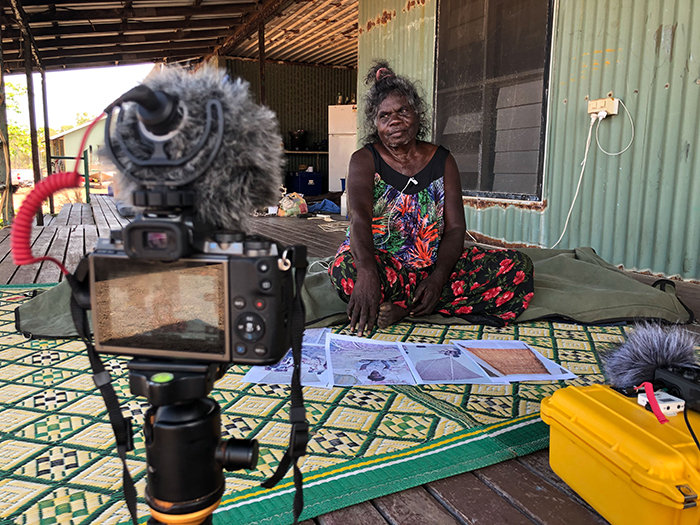
Master weaver and senior Garrawurra custodian Margart Rarru on her mother’s country at Laŋarra sharing stories about Macassans and lipa-lipa (dugout canoe). She is referencing photos from our Djalkiri collection donated by David Morgan.
Senior Warrawarra leader Susan Bulbunga referencing a Djalkiri collection photo that was returned from Kluge-Ruhe in America. She is comparing two works with the same miny’tji (clan design) painted by her gutharra (maternal grandson) Thomas Roy and sharing the story held in this miny’tji for the Djalkiri Keeping Place’s living archive.

Senior Warrawarra leader Susan Bulbunga referencing a Djalkiri collection photo that was returned from Kluge-Ruhe in America. She is comparing two works with the same miny’tji (clan design) painted by her gutharra (maternal grandson) Thomas Roy and sharing the story held in this miny’tji for the Djalkiri Keeping Place’s living archive.
The Yolŋu term djalkiri means “foot”, “footprints”, “roots” or “foundations”. It refers to the knowledge of the ancestors. We might say for example, “Ŋupan limurr ga djalkiri”, “We are following the footprints of our ancestors”. The word points towards the Yolŋu ancestors who gave language and law, and of the elders who came before us that we remember as keepers of that language and law. Djalkiri means to look to the foundations of the past to teach us how to move forward.
On Milingimbi, memory and cultural practice remain strong, threading through all aspects of daily life. The past century has however been marked by social disruption and upheaval, and accommodation to loss – both human and material – is an ongoing challenge.
From the 1920s, when the community was first formalised as a Methodist mission and a number of Yolŋu clans were permanently brought together in one place, Milingimbi has been a centre for cultural innovation. It also became a focus for the attention of anthropologists and subsequently art collectors, particularly from the 1940s. An enormous range of artwork and objects of material culture were studied and compiled into collections which were removed to institutions nationally and overseas. Whilst this means that a valuable cultural repository exists it has, until recently, been effectively lost to those for whom it is most meaningful and valuable.
The Djalkiri Keeping Place’s mission is to embark on a process of digital cultural return, which emerged from Art Centre and community aspirations for a safe and convenient place to access our cultural heritage that now lives in museums and art galleries all over the world. The Keeping Place works from within the Milingimbi Art and Culture to contact these collecting institutions to facilitate digital repatriation of images of the artworks, objects and photos taken and collected from Milingimbi over the last one hundred years. To date we have repatriated over 15,000 images of people, ceremony, country, artworks and objects. Building on the relationships and protocols for engagement we have forged with a growing number of collecting institutions, we hope to recover many more.
The process of organising and utilising this archive is dynamic and challenging, with imperatives specific to the families of Milingimbi. For example, images are not simply catalogued and stored – essential cultural information must be sought from the appropriate people and decisions made as to who has permission to access them later, following protocols for age, gender and levels of initiation. They must be archived according to Yolŋu categories and search terms, using the appropriate languages.
To best meet these needs we are currently collaborating with a well-established Indonesian-based Indigenous arts and culture organisation developing a unique collections management database. We do this work in consultation with the community, our linguist, software developers and other industry professionals. As this develops, we are providing ongoing training for our arts workers in own-language literacy, as well as collections documentation and management. This work is generously supported by funding from the Tim Fairfax Family Foundation.
The goals of the Djalkiri Keeping Place are multi-faceted. Of primary importance is reconnecting Yolŋu artists and the Yurrwi community with their own documented past – unseen images and recordings of family members, community history, cultural material and practices. It will offer opportunities for intergenerational language and cultural transmission, whilst buffering the impact of the steady loss of older generations and the intangible archive they embody. In the absence of the pieces themselves, digital archives are also a rich resource for contemporary art practitioners wanting to reconnect with historic objects to guide their ongoing art practice.
The Keeping Place is also a point of connection to people beyond Milingimbi who would like to engage with Yolŋu artists and cultural leaders in the art and culture realm. Following protocols for ensuring ICIP (Indigenous Cultural and Intellectual Property) and moral rights, information can be shared between institutions and communities to mutual benefit. While permission for this sharing is always obtained on a case-by-case basis from relevant community members who own these rights, many artists and senior elders that engage with repatriated collections are adamant that these collecting institutions that care for our cultural heritage should ensure their documentation is correct and storage is appropriate to Yolŋu law and cultural aspirations.
The Djalkiri Keeping Place reclaims our capacity to speak for and respond to elements of our historical heritage now dispersed, of immeasurable benefit to our health, economic and cultural sustainability. As our past is birthing our future, so we walk in the footsteps of our ancestors.
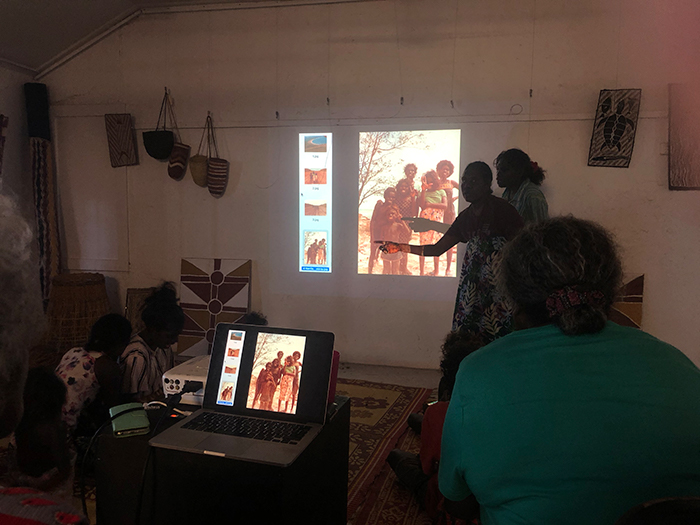
Helen Ganalmirriwuy and Rosemary Ḏatu with family at a Djalkiri slide night discussing old photos of kin returned by homelands teacher Linda Jenkins.
Susan Yirrawur paints a Garrawurra miny’tji referencing an earlier work painted by her ŋapipi Mickey Dorrŋ, a work currently held by Kluge-Ruhe in America.
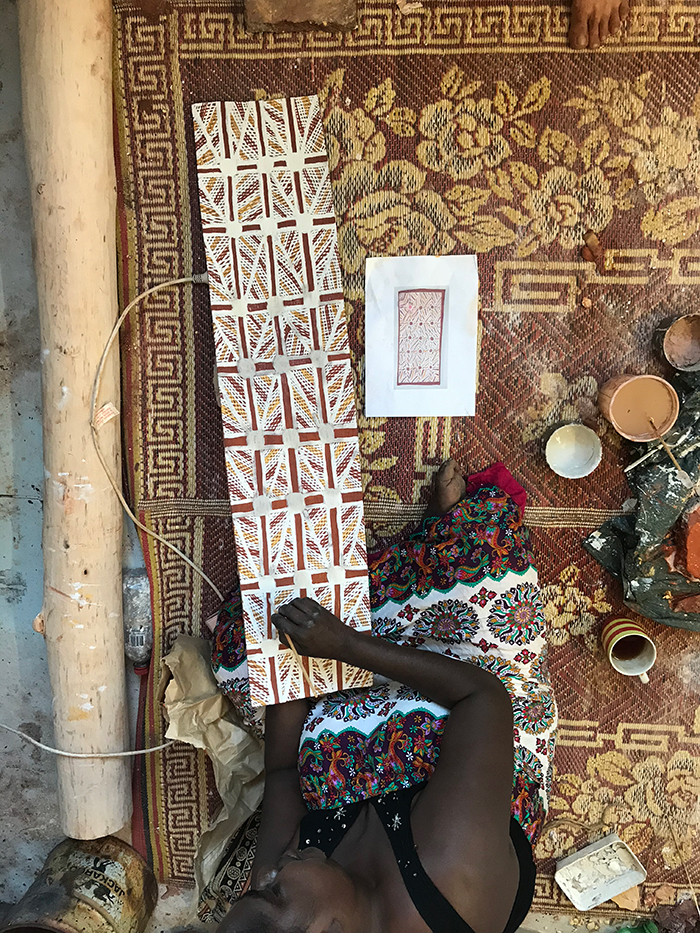
Susan Yirrawur paints a Garrawurra miny’tji referencing an earlier work painted by her ŋapipi Mickey Dorrŋ, a work currently held by Kluge-Ruhe in America.
